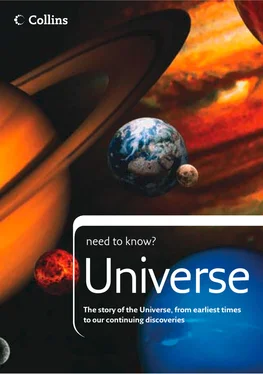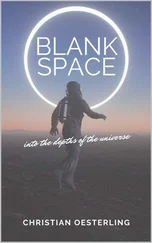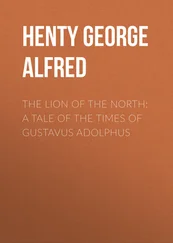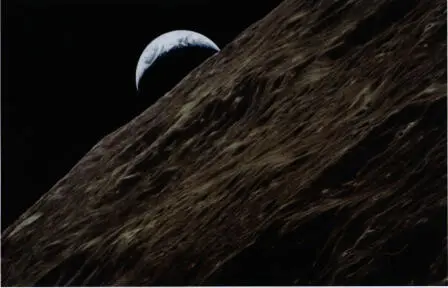
A crescent Earth rises over the rugged lunar surface, photographed by the crew of Apollo 17.
From his vantage point in the command module of Apollo 8 above the Moon in December 1968, astronaut Jim Lovell described planet Earth as a ‘grand oasis in the big vastness of space’. This grand oasis, a beautiful blue globe, two-thirds of whose surface is covered with water, measures 12,756km across. Our planet is the only place in the Universe known to have life. The fossil record shows that life has clung tenaciously to the Earth’s surface for billions of years, surviving the devastating effects of numerous major geological and cosmic catastrophes. Although mass extinctions of many species of animals have occurred, life – in one form or another – has carried on. Just a few dozen kilometres beneath the Earth’s solid crust is a hot mantle – a zone of molten rock which hasn’t cooled down since the Earth was born some 4.5 billion years ago. The Earth’s crust occasionally splits in a volcanic eruption, allowing this material to erupt onto the surface.
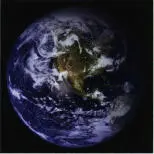
Earth – the grand oasis.
The same gravity that keeps you anchored to the Earth keeps the Moon in orbit. With a diameter about the same as the width of the continental USA, the Moon orbits at an average distance of 384,401km. It took the Apollo spacecraft a few days to traverse the gulf of space between the Earth and Moon, but it would take about a month to get there at the speed of a commercial jet airliner. Second in brilliance to the Sun, the Moon is 400 times smaller than the Sun, but as it is 400 times closer to the Earth, the Sun and Moon appear about the same size in our skies. As the Moon orbits the Earth every month, it goes through a sequence of phases, broadening from a narrow crescent in the evening skies to full Moon in around two weeks, and then becoming narrower again until it is a thin crescent in the morning skies.
At new Moon, the Moon is sometimes seen to move directly in front of the Sun, blocking its light and causing a partial or total eclipse. At full Moon, the Moon sometimes enters the Earth’s shadow and undergoes a partial or total lunar eclipse. Solar and lunar eclipses can be awesome sights.
From little Mercury, whose rocky surface is scorched by the heat of the Sun, to countless deep-frozen cometary chunks from whose surface the Sun appears as a bright point, a remarkable collection of planets, asteroids and comets makes up the Solar System.

Two planetary monarchs compared – Earth, queen of the terrestrial planets, and Jupiter, king of the gas giants.
Our immediate planetary neighbours – Mercury, Venus and Mars – are solid worlds like the Earth. Between Mars and the outer planets of the Solar System lies a zone occupied by countless chunks of rock. These remnants of the Solar System’s formation range from the size of houses to the size of Iceland and are known as asteroids. Four giant planets preside over the outer reaches of the Solar System. Jupiter, Saturn, Uranus and Neptune are all swathed in thick layers of mainly hydrogen gas. Jupiter, the largest gas giant, is so big that a thousand Earths could comfortably fit inside its vast volume. Pluto, the outermost planet, is a diminutive world, smaller in fact than our own Moon. More than four light hours from the Sun, Pluto is one of a number of icy worlds at the cold fringes of the observable Solar System. Far beyond the planets, clinging on to the Sun’s gravity to a distance almost half way to the nearest stars, lies an unseen realm of comets known as the Oort Cloud. Cometary visitors from this distant region occasionally speed through the inner Solar System; warmed by the Sun, their icy nuclei emit large amounts of gas and dust, producing celestial spectacles like the magnificent Comet Hyakutake of 1997.
The Sun, attended by its nine major planets and their satellites, along with hundreds of thousands of asteroids and comets, orbits the centre of a vast spiral galaxy of some 300 billion stars called the Milky Way. A middle-aged resident of the galactic suburbs, the Sun is located around 26,000 light years from the galactic centre – about half way from its centre to the edge, within one of the galaxy’s spiral arms. Orbiting the Milky Way at a speed of around 220km per second, the Sun has made around 20 galactic circuits since its birth around five billion years ago.
Measuring around four light years across (if we include the Oort Cloud), the Solar System occupies a tiny part of the Milky Way galaxy, some 100,000 light years in diameter. Indeed, the Sun would not be visible to the unaided eye from a distance of much more than 50 light years. Viewed from the Alpha Centauri system some 4.5 light years away, the Sun would appear as a bright star in the constellation of Cassiopeia.

Our location within the suburbs of the Milky Way spiral galaxy.
On a clear night it’s possible to see hundreds of stars from a rural location. Each one is a relatively nearby member of our home galaxy, whose further reaches dissolve into a glowing band called the Milky Way.
must know
Beginnings
As we probe further into the depths of space, we are looking ever further back in time towards the beginning of the Universe. That beginning, thought to have taken place less than 14 billion years ago, may have been a single ‘Big Bang’ – the explosion of a primeval atom which created spacetime and matter. What caused this to occur, and what took place before the Big Bang, is still unknown.
Shaped like a flattened disk with a central bulge, our home galaxy the Milky Way is arranged in a loosely-wound spiral, with a number of curving arms composed of stars and glowing gas clouds. Two nearby small satellite galaxies – the Small and Large Magellanic Clouds – drift some distance beyond the edge of the Milky Way. From our perspective deep within an arm of the galaxy, we see the Milky Way as a glowing band which circles the heavens. Looking towards the bright galactic region in the vicinity of the constellation of Sagittarius, we are peering directly towards the centre of the galaxy. Our view of the actual galactic hub is blocked by dense interstellar clouds of dust and gas, which show up as dark silhouettes against the brighter parts of the Milky Way.
Clouds of interstellar dust and gas in Sagittarius obscure our view of the Milky Way’s bright core.
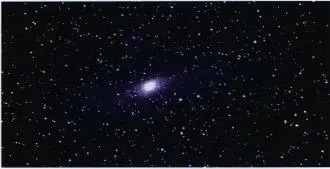
Around 2.9 million light years away lies the Andromeda Galaxy – the nearest big galaxy to our own, the Milky Way.
Читать дальше
